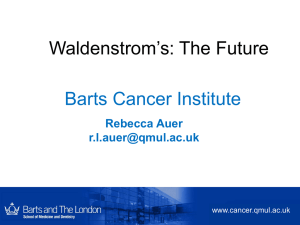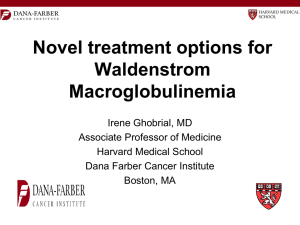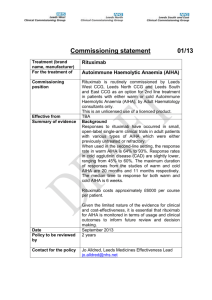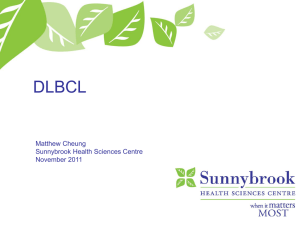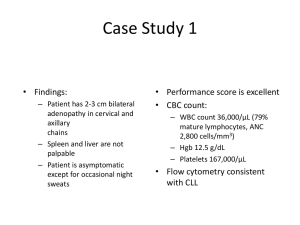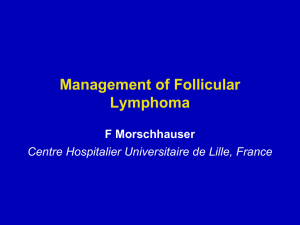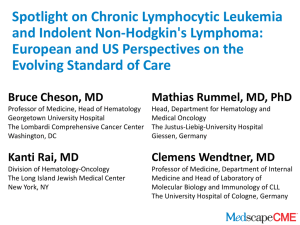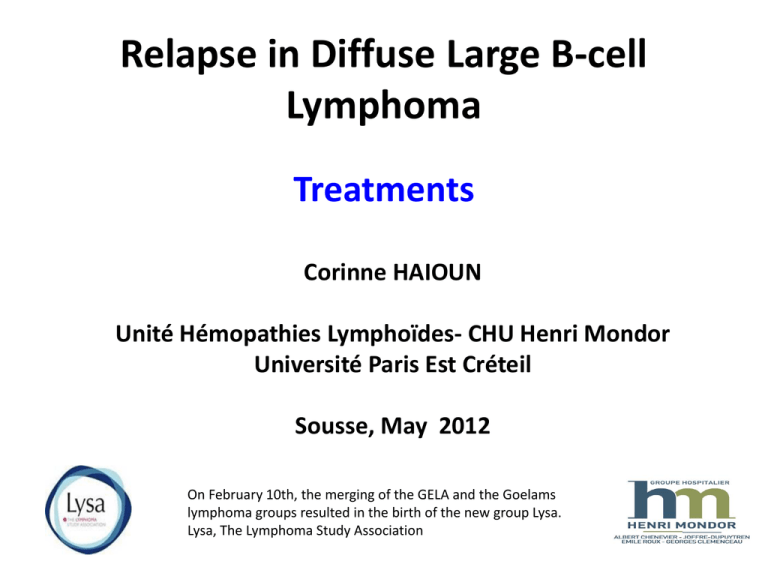
Relapse in Diffuse Large B-cell
Lymphoma
Treatments
Corinne HAIOUN
Unité Hémopathies Lymphoïdes- CHU Henri Mondor
Université Paris Est Créteil
Sousse, May 2012
On February 10th, the merging of the GELA and the Goelams
lymphoma groups resulted in the birth of the new group Lysa.
Lysa, The Lymphoma Study Association
Rituximab effect
• Major breakthrough with the combination of
rituximab with chemotherapy
• R-CHOP became the standard for the majority
of patients
• But some patients continue to not respond to
or relapse after R-CHOP
CD20+ DLBCL
18–60 years
IPI 0,1
Stages II–IV,
I with bulk
(n = 823)
How many patients will relapse?
MInT trial
low risk
Relapse rate
10-20%
Pfreundschuh M, et al. Lancet Oncol 2006;7:379–91
GELA trials
How many patients will relapse?
In DLBCL with ASCT
< 60 yrs, 2–3 aaIPI factors
POOR RISK PATIENTS
ACVBP
Rituximab
HD-MTX
13
LNH98-3B
CBVM
Wk 0
2
4
R
6
Relapse rate
20-30%
Observation
PBSCT
R-ACVBP
HD-MTX
13
LNH03-3B
BEAM
Wk 0
2
4
6
First introduction of rituximab
PBSCT
R-CHOP studies > 60y :
How many patients will relapse?
Relapse rate
40-60%
Low-risk patients
Low-risk patients
High-risk patients
High-risk patients
Coiffier B, et al. ASCO 2007.
Median follow-up 7 y
EFS
PFS
DFS
OS
Registry data also show these improvements
BCCA registry1
Czech Republic registry2
1.0
1.0
Probability
0.8
R-Chemo (n = 120)
3-year OS: 88.7%
0.8
Post-rituximab
0.6
0.6
Pre-rituximab
0.4
0.2
0.4
0.2
N = 292
p < 0.0001
0
0
1
Chemo (n = 256)
3-year OS: 73.2%
p = 0.0007
0
2
3
Time (years)
4
5
6
7
0
12 24 36 48 60 72 84 96
Time (months)
1. Updated from: J Clin Oncol 2005; 23:5027–5033.
2. Blood 2005; 106:Abstract 2444.
GELA randomized studies
•
•
•
•
LNH-87
LNH-93
LNH-98
LNH-03
1. Young, aaIPI=0 (F Reyes)
•
CHOP+RT vs. ACVBP
2. Young aaIPI=1 (P Morel)
•
•
Stratification on bcl-2 protein expression
ACVBP + seq. consol. or HDT
3. Young, aaIPI>1 (C Gisselbrecht)
•
ACVBP vs. early HDT
4. Elderly, IPI=0 (G Fillet)
•
CHOP vs. CHOP + RT
5. Elderly, IPI>0 (H Tilly)
•
CHOP vs. ACVBP
8
Four generations of GELA studies
Total
ACVBP
Other arms
LNH-87
LNH-93
LNH-98
LNH-03
3114
3830
1377
592
1381
1268
585
297
1733
2562
792
295
All
8913
3531
5382
Overall Survival: All patients
7400 patients, 18-80 years old
Coiffier B et al. EHA 2009
10
Studies with/without rituximab
Without rituximab
With rituximab
Coiffier B et al. EHA 2009
Studies with/without rituximab
With rituximab
Without rituximab
Percentage of patients in each groups
Without / With rituximab
No relapse
Late relapse
PR
Early relapse
No response
50
13
8
11
18
61
13
10
8
8
Coiffier B et al. EHA 2009
PFS and OS of 87/93/98 studies
7400 patients
18-80 years old
8-9%
7 years: PFS = 47.5% [46-49%]; OS = 56% [54-57%]
Coiffier B et al. EHA 2009
Parma study: event-free survival
(Updated from JY Blay et al., Blood 1998)
Event-free survival (%)
100
Chemo-sensitive responders:
ORR 58%, CR 25%
80
60
ABMT (n=55)
40
DHAP (n=54)
20
p=0.002
0
0
15
30
45
60
months from inclusion
75
90
Relapsed aggressive lymphoma (DLBCL)
Patients candidates to HDT/ASCT (<60-65y)
Accepted strategy
Short salvage chemotherapy
Evaluation of response
HDT/ASCT
Questions
1.- Which optimal salvage chemotherapy regimen?
2.- Will rituximab combined with salvage chemotherapy be effective if previously
used first-line?
3.- Is rituximab useful as maintenance therapy after HDT/ASCT?
CORAL Trial of RICE v DHAP
Which salvage regimen is the best?
R
A
N
→
D
CD20+ DLBCL
O
Relapsed/Refractory
M
I
Z
E
SD/POD → Off
R-ICE x 3
AB
SE
CA
TM
R-DHAP x 3
R
A
Rx6
N
D
PR/CR →
O
M
I
Z
Obs
E
N=400
Place of immunotherapy post transplantation?
Gisselbrecht C. J Clin Oncol 2010
CORAL Study
Patient distribution
Australasia
60
Cesz Republic
36
Belgium
31
Israel
US
Sweden
13
9
13
UK
50
Germany
France
113
128
Switzerland
24
Ireland
4
481 patients
30/6/2008
Thank you to all investigators and pathologists
Gisselbrecht C et al. JCO 2010;28:4184-4190
PATIENTS ENROLLED IN CORAL STUDY ACCORDING
TO RESPONSE TO FIRST LINE TREATMENT
Arm of treatment
ARM A / RICE
ARM B / RDHAP
All
N
%
N
%
N
%
COMPLETE RESPONSE
129
53
122
52
251
53
UNCONFIRMED COMPLETE
RESPONSE
31
13
24
10
55
12
PARTIAL RESPONSE
44
18
49
21
93
20
STABLE DISEASE
11
5
13
6
24
5
PROGRESSIVE DISEASE
27
11
25
11
52
11
NOT EVALUATED
0
0
1
1
1
0
Response after first line
Gisselbrecht C et al. asco 2011
PATIENTS CHARACTERISTICS
Median age
Sex
M
F
R-ICE (243)
R-DHAP (234)
54 y
55 y
156
87
147
87
93
149
89
143
ENS > 1
67
78
LDH > Nl
126
117
S-AaIPI 0-1
S-AaIPI 2-3
142
93
139
88
<12 months
107
106
12 months
133
122
Stage I-II
Stage III-IV
Gisselbrecht C et al. asco 2011
RESPONSE TO INDUCTIVE SALVAGE TREATMENTS
R-DHAP
R-ICE
N 239
%
N 230
%
COMPLETE RESPONSE
57
24
60
26
UNCONFIRMED COMPLETE RESPONSE
3063 .6 % 13
25
PARTIAL RESPONSE
65
27
63
27
STABLE DISEASE
26
11
26
11
PROGRESSIVE DISEASE
46
19
Response including deaths
DEATH
PREMATURE WITHDRAWAL / NOT
EVALUATED/missing
Total
Arm of 7
treatment
Nb patients
R-ICE8
239
R-DHAP
230
239
3
2
100
64.311%
Nb
39
responders
with
11
successful
mobilization
MARR (%)
1236
51.5
2
130
56.5
230
Gisselbrecht C et al. asco 2011
17
5
100
CONSOLIDATION with BEAM
Arm of treatment
ARM A / R-ICE
ARM B / R-DHAP
N
%
N
%
Yes
123
51
132
57
No
116
49
98
43
197
100
191
100
Consolidation treatment (BEAM)
Total
Main Reasons for premature withdrawals:
•Progressive lymphoma: 53%
•Toxicity: 7%
•Collection failure: 7-11% (CD 34/kg < 2.106)
•Deaths: 4%
Gisselbrecht C et al. asco 2011
EFS and OS by induction treatment
481 patients first randomised from 24 July 2003 to 30 June 2008
245 patients randomised in the second part from 21 October 2003 to 21 October 2008
EFS (induction ITT)
1.0
R-ICE
R-DHAP
Survival probability
Survival probability
1.0
OS (induction ITT)
0.8
0.6
0.4
0.2
p = 0.2672
0.0
0
12
R-ICE
R-DHAP
0.8
0.6
0.4
0.2
p = 0.3380
0.0
24
36
48
EFS (months)
No. of
subjects
Event
60
72
0
12
24
36
No. of
subjects
Censored Median
48
OS (months)
Event
60
72
Censored Median
R-ICE
239
71% (170) 29% (69)
6.51
R-ICE
239
52% (125) 48% (114)
34.53
R-DHAP
230
67% (153) 33% (77)
7.49
R-DHAP
230
49% (112) 51% (118)
58.97
64%
N=160
31%
N=228
PROGRESSION-FREE
SURVIVAL
ACCORDING TO FAILURE
FROM DIAGNOSIS
(INDUCTION ITT)
62%
N=147
30%
N=241
PROGRESSION-FREE
SURVIVAL ACCORDING TO
PRIOR RITUXIMAB
(INDUCTION ITT)
EVENT-FREE SURVIVAL BY PRIOR RITUXIMAB ITT
Failure from diagnosis =>=INDUCTION
12 months
Failure from diagnosis > 12 months
N= 106
N= 54
Failure from diagnosis =< 12 months
Standard salvage regimen does not
overcome poor prognosis
of early relapse
N= 41
N= 187
CORAL STUDY RESPONSE RATE ACCORDING TO
PROGNOSTIC FACTORS
Patients
Response
CR/Cru/PR
p
All patients
245
63 %
CR/CRu
147
38%
No
Yes
122
124
83%
51%
<0.0001
Relapse > 12 months
Refractory < 12 months
140
106
88%
46%
<0.0001
s IPI
160
76
71%
52%
<0.0002
Prior Rituximab
<2
>1
TAKE HOME MESSAGES
based on CORAL study
A new profile of relapses and refractory patients after
rituximab is seen
Prognostic factors affecting response and survival
are:
• relapse < 12 months
• secondary IPI>1
• prior rituximab exposure
When rituximab has been used during first-line
therapy: optimal salvage combination remains to be
determined? New drugs mandatory
–
CORAL Trial of RICE v DHAP
Which salvage regimen is the best?
R
A
N
→
D
CD20+ DLBCL
O
Relapsed/Refractory
M
I
Z
E
SD/POD → Off
R-ICE x 3
AB
SE
CA
TM
R-DHAP x 3
R
A
Rx6
N
D
PR/CR →
O
M
I
Z
Obs
E
N=400
Place of immunotherapy post transplantation?
Gisselbrecht C. J Clin Oncol 2010
CORAL maintenance:
PFS/OS by treatment arm
PFS
OS
1.0
Observation
Rituximab
0.8
0.6
0.4
0.2
p = 0.8314
0.0
0
12
Survival probability
Survival probability
1.0
Observation
Rituximab
0.8
0.6
0.4
0.2
p = 0.7547
0.0
24
36
48
60
72
PFS (months)
0
12
24
36
48
60
72
Overall survival (months)
n
Event
Censored Median
Observation
120
43% (52)
57% (68)
58.22
Observation
120
33% (40) 67% (80)
62.92
Rituximab
122
45% (55)
55% (67)
57.59
Rituximab
122
36% (44) 64% (78)
NA
n
Event
Censored Median
CORAL: Prognostic factors for maintenance
post-ASCT – multivariate Cox Model
EFS
PFS
OS
Parameter
p-value
Hazard
ratio
(95% CI)
p-value
Hazard
ratio
(95% CI)
p-value
Hazard
ratio
(95% CI)
Prior treatment with
rituximab: no
0.1979
0.748
0.3509
0.808
0.2874
0.760
Failure from diagnosis
< 12 months
0.4658
1.179
0.4536
1.188
0.5665
1.159
Age-adjusted IPI 2–3
0.0030
1.846
0.0007
2.028
0.0004
2.252
Response after complete
induction: PR
0.2050
1.295
0.4286
1.180
0.4638
1.186
Arm of treatment: R-ICE
0.0853
1.417
0.0676
1.457
0.0716
1.511
Arm of second
randomisation: Rituximab
0.9208
1.020
0.6104
1.111
0.4822
1.175
Survival probability
CORAL maintenance:
OS by gender
1.0
Female
Male
0.8
0.6
0.4
0.2
p = 0.0066
0.0
0
12
24
36
48
60
72
OS (months)
Analysis of maximum likelihood estimates
Parameter
DF
Parameter
estimate
Standard
error
Chi-Square
Pr > ChiSq
Hazard
eatio
95% Hazard ratio
confidence limits
brasrand2
RITUXIMAB
1
0.19196
0.22723
0.7137
0.3982
1.212
0.776
1.891
aaipi
2-3
1
0.89373
0.22754
15.4281
<.0001
2.444
1.565
3.818
SEX
MALE
1
0.63522
0.25860
6.0341
0.0140
1.887
1.137
3.133
Gisselbrecht C, et al..
Patients randomized
N = 400
MATERIAL
: Paraffin blocks
Patients analyzed
N = 249 (63%)
Diagnosis
Relapse = CORAL
Primary Biopsy
N = 189 (47%)
Relapse Biopsy
N = 147 (37%)
Matched pairs
N = 87 (22%)
Subclassification of de novo DLBCL
(Hans CP et al. Blood. 2004)
+
GCB
GCB
+
non-GCB
MUM1
CD10
+
_
bcl6
5-Year OS
FR
_
GCB
non-GCB
76%
34%
_
non-GCB
Progression Free Survival
Hans algorithm
GC
Non GC
R-DHAP
R-ICE
R-ICE (n=61)
R-DHAP (n=54).
52%
31%
R-ICE (n=56)
27%
3 years
p = NS
R-DHAP (n=61)
32%
3 years
p = 0.04
Thieblemont C et al JCO 2011
C-MYC probe, split-signal
Pattern
YY
YGR
MYC+ DLBCL treated in CORAL study
Cuccuini W. et al., Blood 2012
Patients analysed ( n=161)
MYC +
Simple
Complex
BCL2
BCL6
BCL2 and BCL6
MYC No breakpoint
n
28
17 %
7
21
13
4
4
133
83 %
MYC+ DLBCL is associated with a
poor prognosis
MYC- n=133
MYC+ n=28
PROGRESSION FREE SURVIVAL
OVERALL SURVIVAL
62%
42%
18%
4 years
29%
4 years
p = 0.0322
p = 0.0113
Cuccuini W. et al Blood 2012
MYC+ DLBCL : No impact of treatment arm
MYCMYC+
OVERALL SURVIVAL
R-DHAP
R-ICE
26%
3 years
31%
3 years
p = .1832
p = .0324
Cuccuini W. et al Blood 2012
TAKE HOME MESSAGES
Molecular characteristics are “similar” at diagnosis and
relapse.
• Differential efficacy of non-based anthracycline chemotherapy
within molecular subtypes of DLBCL
• MYC rearrangement is associated with a bad prognosis,
independently from the type or treatment or other biological
prognostic classification
Importance of realizing molecular characterization in DLBCL
for a rational development of treatment.
Clinical prognostic factors remain very important
Elderly patients (>65y), not
eligible for HDT
No standard of care
R- GemOx, R GDP, ESHAP, VIM,
Ifosfamide-etoposide…
R - GemOx Protocol
Rituximab
375 mg / m2
Gemcitabine 1000 mg / m2
Oxaliplatin
100 mg / m2
d1
(10 mg / m2 / min)
d2
( over 2 hours,
after Gemcitabine
administration )
d2
8 CYCLES DELIVERED EVERY 2 WEEKS
No dose adjustment for hematological toxicity.
Next cycle delayed until recovery
( A N C > 1 x 109 / L and platelets > 100 x 109 / L ).
In case of neurotoxicity, dose reduction
was planned for oxaliplatin only.
Haioun C et al. ASCO 2010
R - GemOx Study : Study design
Consolidation
Induction
C1
E
C2
C3
C4
C5
C6
C7
Follow-up
0
C8
RGEMOX
R-
R-
R-
R-
R-
R-
R-
GEMOX
GEMOX
GEMOX
GEMOX
GEMOX
GEMOX
GEMOX
W0
W2
W4
W6
W8
W10
W12
W14
Evaluation of response:
if CR, CRu or PR, start
consolidation
E = Enrollment
W = Week
C = Cycle
W16
Response
to
treatment
Patient Characteristics ( n = 49 )
Median time between last TX
and start of R-GEMOX (months)
Primary refractory, (%)
14 [ 1 - 130 ]
6
(12%)
1st relapse, (%)
36
(74%)
2 nd relapse, (%)
7
(14%)
22
(46%)
Delay from last TX < 1 year, (%)
PREVIOUS THERAPIES
ACVBP / CHOP / Others (%)
67 / 31 / 2
Rituximab, (%)
37
(63%)
Autologous stem cell Transplantation, (%)
13
(27%)
Response after induction TX
(4 cycles)
n
%
Complete Response
11
23
60.4 %
Unconfirmed Complete
Response
10
21
Partial Response
CI :
[ 45.3% - 74.2% ]
8
17
Stable Disease
2
4
Progressive Disease
5
10
Death
4
8
Premature withdrawal
8
17
48
100
Total
Response at the end of TX
n
%
11
23
45.8 %
Unconfirmed Complete
Response
7
15
Partial Response
CI :
[ 31.4% - 60.8% ]
4
8
Stable Disease
4
8
13
27
Death
8
17
Not evaluated
1
2
48
100
Complete Response
Progressive Disease
Total
Progression - Free Survival
Survival probability
1
0.8
0.6
Median follow-up: 41 months
0.4
0.2
0
0
6
12
18
24
30
36
42
48
Months
3 - year PFS rate
Median PFS (months)
20.1% [ 9.8 - 32.4 % ]
5.3
[ 2.6 - 9.6 % ]
54
60
Survival probability
PFS according to delay from last
1
Treatment (< or > 1 year )
0.8
Time last treatment / C1 < 1 year
Time last treatment / C1 > 1 year
0.6
p = 0.0166
0.4
0.2
0
0
6
12
18
24
30
36
42
48
Months
n
Time of last treatment / C1 < 1 year
Time of last treatment / C1 > 1 year
22
26
MEDIAN MONTHS)
3
10
54
60
PFS according to delay from last TX
( < or > 1 year ) and
previous rituximab TX
Survival probability
1
0.8
Previous rituximab : No & Time last treatment / C1 < 1 year
Previous rituximab : No & Time last treatment / C1 > 1 year
Previous rituximab : Yes & Time last treatment / C1 > 1 year
Previous rituximab : Yes & Time last treatment / C1 < 1 year
0.6
0.4
0.2
p < 0.0001
0
0
6
12
18
24
30
36
42
48
Months
PREVIOUS TIME LAST
RITUXIMAB TX AND C1
N
MEDIAN
95% CI
LOWER
95% CI
UPPER
MIN
MAX
No
< 1 Year
7
12
5
-
1
49
PFS
No
> 1 Year
10
11
7
-
1
46
(months)
Yes
< 1 Year
15
2
1
3
0
6
Yes
> 1 Year
16
9
5
30
1
55
54
60
TAKE HOME MESSAGES
This prospective multicenter trial suggest that
R - GemOx regimen is a safe outpatient salvage
regimen.
The response rate of 60%, after 4 cycles, observed
across a wide age range of patients appears similar to
the response rate obtained with other salvage regimens
(RICE, R-DHAP…) and appears less toxic.
The familiarity of practicing oncologists with the
GemOx combination for other malignancies will allow it
to be largely applied to lymphoma.
A new profile of patients relapsing less than one
year after the end of last treatment and previously
treated xith rituximab come out from this trial
(median PFS: 2 months), and will help the design
of future studies with new drugs
This regimen could be considered as a platform
for new combinations
Targeted Therapy for Cancer
Younes A. (2010) Beyond chemotherapy: new agents for targeted treatment of lymphoma.
Nat Rev Clin Oncol. doi:10.1038/nrclinonc.2010.189.
Mounier N, Gisselbrecht C. Best Practice and Research Clinical Hematology, 2012
Monoclonal antibodies
Naked MAb
Rituximab
anti-CD20
Alemtuzumab
anti-CD52
Epratuzumab
anti-CD22
Galiximab
anti-CD80
Humanized anti-CD20s (ocraluzumab, ofatumomab, veltuzumab)
Modified anti-CD20s (GA 101, R603)
Bevacizumab
anti-VEGF
Zanolimumab
anti-CD4
siplizumab
anti-CD2
MAb + radionucleide
90Y ibritumomab tiuxetan
131I tositumomab
anti-CD20
anti-CD20
MAb + toxin
CMC-544 (calicheamicin)
SAR3419 (DM4, maytansinoid)
anti-CD22
anti-CD19
Inotuzumab ozogamicin Structure
(CMC-544)
Structure of CMC-544, a CD22-targeted immunoconjugate of CalichDMH
Humanized IgG4
anti-CD22 mAb G5/44
AcBut linker
O
O
O
NH
Me
Me
NHN
CH3
I
OCH 3
OCH 3
OCH 3
O
OH
CH3
CH3
HN
OH
O
H
O
HO
O
CH3 CH2
O
N
CH3
O
OCH 3
O
OCH 3
O
Adapted from:
1. DiJoseph JF et al. Blood. 2004;103:1807-1814.
NH
S
O
S
O
CH3
HO
Me
O
O
HO
S
Calicheamicin
|| August
03 Feb 2011
2010
Depositato presso AIFA in data 20/09/2010
Response Rate With Inotuzumab Ozogamicin at the
MTD (1.8 mg/m2)
How to combine CMC with chemotherapy ?
Main toxicity thrombocytopenia
Phase II R-GEMOX/R-CMC 544 in Recurrent DL
B-cell Lymphomas
Dose levels
Recurrent CD22+ B-cell NHL
rituximab
56 70
84
98 112 126 140
168 182
GEMOX
GEMOX
GEMOX
GEMOX
GEMOX
42
rituximab
GEMOX
28
GEMOX
1
rituximab
GEMOX
Enrollment
rituximab
-2 = 0.8 mg/m2
-1 = 1.3 mg/m2
0 = 1.8 mg/m2
inotuzumab
Re-stage
NHL, non-Hodgkin’s lymphoma. F Offner, C Haioun
Re-stage
MERCI !!!

